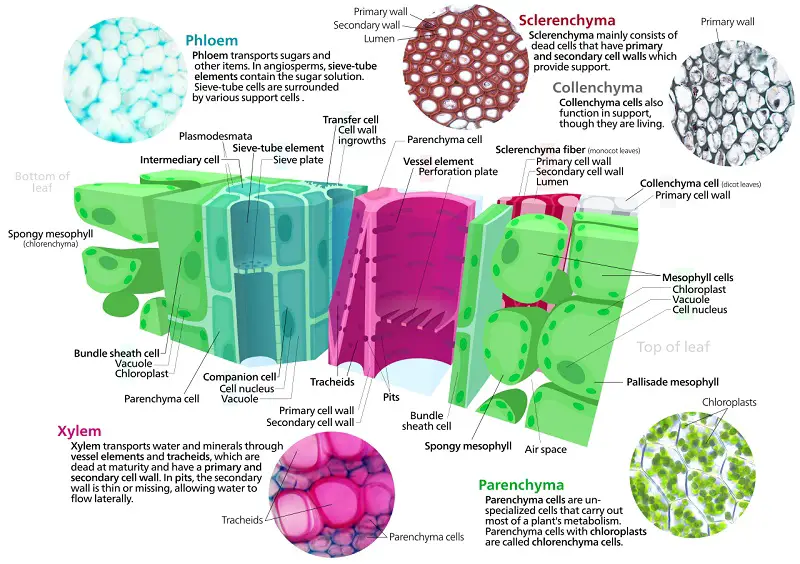Plant Cell Types
Viewed under a microscope, what looks to be stationary on the outside is actually teeming with life. In this reviewer, you’ll learn the different types of plant cells that may look different from each other but all accomplish one goal–to ensure the plant’s survival.
Plant Cell: An Overview
In addition to features shared with other eukaryotic cells, most plant cells have three unique structures: the chloroplast, a large central vacuole for maintaining the cell’s firmness, and a protective cell wall.
Many plant cells have a two-part cell wall. A primary cell wall forms first, and then a more rigid secondary wall forms between the plasma membrane and the primary wall. The primary walls of adjacent cells in plant tissues are held together by a sticky layer called the middle lamella.
The cell wall we have mentioned in a previous article can have pits for allowing water to migrate between adjacent cells and plasmodesmata which are open channels in adjacent plant cell walls that allow various molecules to pass from one cell to another.
The structure of the plant cell and its walls correlate with their functions, a theme that is always prevalent in biology. As such, we will now take a closer look at the different cell types in plants.
Types of Plant Cell

1. Parenchyma Cell
Parenchyma cells are the most abundant cell type in most plants. They usually have only primary cell walls that are thin and flexible. Parenchyma cells perform most metabolic functions of the plant. They can also divide into other types of plant cells under certain conditions.
2. Collenchyma Cell
Collenchyma cells resemble parenchyma cells in lacking secondary walls, but they have unevenly thickened primary cell walls. The cells provide flexible support in actively growing parts of the plant with young stems and petioles often having collenchyma cells just below their surface. These living cells elongate as stems and leaves grow.
3. Sclerenchyma Cell
Sclerenchyma cells have thickened secondary walls usually strengthened with lignin, an important chemical component of wood. Mature sclerenchyma cells cannot elongate and thus are found in regions of the plant that have stopped growing in length. As such, when they mature, most sclerenchyma cells die and their remaining cell walls support the plant the way steel beams do for a building’s interior.
Sclerenchyma cells can be fiber, long and slender cells usually arranged in strands. These fiber cells are found in commercially important plants such as hemp fibers, used for making rope and clothing, and flax fibers which are woven into linen. Sclereids are shorter than fiber cells but have thick, irregular, and very hard cell walls. Sclereids impart the hardness to nutshells and seed coats and the gritty texture we feel when touching a pear.
Xylem and Phloem Tissues
The xylem tissue of angiosperms includes two types of tubular water-conducting cells: tracheids, which are long, thin cells with tapered ends; and vessel elements which are wider, shorter, and less tapered. Chains of tracheids or vessel elements aligned end-to-end to form a system of tubes that convey water from the roots to the stems and leaves. When mature, the xylem tissues die and leave behind their cell walls which allows water transport.
Food-conducting cells known as sieve-tube elements are also arranged end-to-end and are part of the phloem tissue. But unlike water-conducting cells, sieve tube elements remain alive at maturity but lose most of their organelles. This reduction in cell content allows them to facilitate the transport of nutrients.
The end walls between sieve-tube elements are called sieve plates and have pores that allow fluid to flow from cell to cell along the sieve tube. Alongside each sieve-tube element is a companion cell, which produces and helps transport proteins to their connected sieve-tube element.
These cells form tissues, and tissues form organs. All these structures contribute to a plant’s growth, a topic we will be delving into next.
Next topic: Plant Growth
Previous topic: Plant Tissue Systems
Return to the main article: Plant Form and Functions
Download Article in PDF Format
Test Yourself!
1. Practice Questions [PDF Download]
2. Answer Key [PDF Download]
Copyright Notice
All materials contained on this site are protected by the Republic of the Philippines copyright law and may not be reproduced, distributed, transmitted, displayed, published, or broadcast without the prior written permission of filipiknow.net or in the case of third party materials, the owner of that content. You may not alter or remove any trademark, copyright, or other notice from copies of the content. Be warned that we have already reported and helped terminate several websites and YouTube channels for blatantly stealing our content. If you wish to use filipiknow.net content for commercial purposes, such as for content syndication, etc., please contact us at legal(at)filipiknow(dot)net
